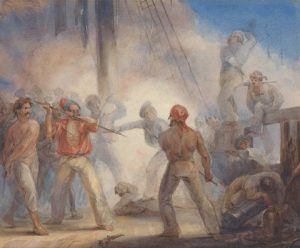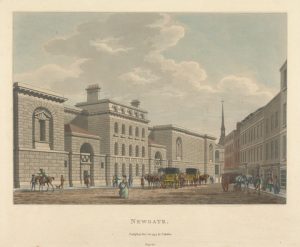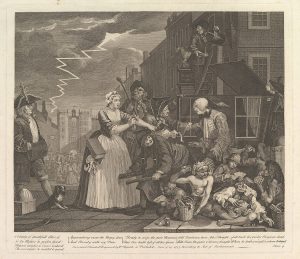
A Rake’s Progress, Plate 4, print, William Hogarth (MET, 91.1.86). 25 June 1735. Etching and engraving; third state of three. plate: 14 1/16 x 16 1/4 in. (35.7 x 41.3 cm); sheet: 15 3/4 x 18 3/4 in. (40 x 47.7 cm). Wikimedia Commons.
Try this experiment: Google “child” and “criminal.” Pages and pages of horrific crimes committed by adults against children will pop up. Now search “juvenile” and “criminal.” This time you will either find instances of local politicians ranting against dangerous marauding boys roaming the streets to steal cars, or activists from non-profits bewailing the injustices of a legal system that incarcerates disadvantaged youth. Both search results show young individuals’ interactions with adults, but those victimized are children and those perceived as predatory are juveniles.
This current use of “juvenile” as the preferred term to denote children who commit crimes is a legacy of nineteenth-century justice reform that created a separate set of laws for young criminals and set up the first “juvenile prison” (Griffiths). Before that, the word “juvenile” occurred rarely in legal discourse. In the eighteenth century, children were subject to the same laws as adults, they could be transported to penal colonies or incarcerated along with older, hardened criminals. According to the letter of the law, children under seven could not be charged with a felony as they did not yet know “right from wrong,” and at fourteen a child had full criminal liability as an adult. But the years eight to fourteen were a kind of gray area in which the court had to judge the youthful offender’s guilt and levy appropriate punishment. As ages of street children were difficult to determine, for all intents and purposes they often were as vulnerable to harsh punishments as any adult (Giovanopoulos).
The plight of these young criminals–not yet the legal “juvenile” we recognize today, suspended unstably between child and adult in the court of law–sparked the imagination of contemporary novelists. Particularly, the prevalence of boy gangs on London streets working together to steal from passersby and shop windows has been famously preserved for us in literature by Daniel Defoe’s 1722 depiction of bands of roving boys “Bred up for the Gallows” in Colonel Jack and by Charles Dickens’s 1838 creation of Fagin’s network of pickpockets in Oliver Twist[i] (Defoe).
But what of the real boy gangs from the period that caught the attention of these novelists? Were they childlike? Or hardened adult-like criminals? This is the story of one such gang operating in eighteenth-century London.
In 1737, the courtroom at Old Bailey courthouse in London saw the collapse of a gang of shoplifters, consisting of about seven or eight young boys along with their “receiver,” the adult Nichols Correl, who bought their stolen goods (“Trial of Thomas Chap, Nicholas Correl”). The story of this network of thieving boys comes from trial transcripts published in the Old Bailey Proceedings, a periodical publication meant for popular audiences–the older version of today’s true-crime podcasts perhaps (Shoemaker). Though supposed to be a factual documentation of the cases heard in the Old Bailey Courthouse, the OBP catered to the hearty eighteenth-century appetite for real life crime narratives. But as a collation of all the trials held at a major court in London, the sheer volume of trial information available in the OBP is also an unmatched source for researchers today studying the nuances of youth crime before the emergence of laws, prisons, and institutions geared specifically towards juvenile offenders. Not that the image of criminal children preserved in the OBP is holistic enough to be accurate. After all, these trial narratives, though meant for the reading pleasure of popular audiences, are also fundamentally pro-court publications, unquestioningly accepting the fundamental integrity of the legal proceedings as well as its ability to deliver justice effectively. Think of our own Law and Order episodes “based on real cases”– as riveting as they might be, they never really question the necessity or morality of the legal system. Still, even with these caveats about the accuracy or reliability of the OBP trial transcripts, it remains one of the most important repositories of information about criminal children in the past.
So, the 1737 OBP account of two trials involving Nicholas Correl, our real-life Fagin, and a “Gang of Boys” stealing from shops or passersby, preyed upon by adult crooks, and targeted by the law is useful for thinking about the culpability, vulnerability, as well as vitality of boy criminals both then and now (“Trial of Richard Murray”). The boy gang of the eighteenth century was nothing like the youth gangs we have today, of course, with their strong identity affiliations and violent initiation rituals. Instead, they were more likely to be a loose network based on shifting and contingent connections made with other youth in order to pilfer from pedestrians or storefronts. Ironically, though, the “neighborhood watch” style surveillance meant to keep streets safe from criminal elements that has become so notorious today was very much in force even in the eighteenth century. Indeed, one might say it was even the norm.
The story of Nicholas Correl and his gang began when Ann Wibley, who owned a shop in Petty France, Westminster, discovered two bolts of checked cotton and thirty pairs of stockings missing from her shop. She immediately suspected “a parcel of Boys” seen loitering around her neighborhood and marched to the local constable, Robert Adams, intent on having them arrested for questioning. Wibley was not a “Karen” even though she seems to have acted so by today’s standards. Indeed, her behavior was the recommended approach to suspicious behavior. Like a “neighborhood watch” on steroids, eighteenth-century Londoners were expected to always be on the lookout for potential criminals, identify suspects and even apprehend wrong-doers before contacting a constable (“Policing in London”). And in this, Wibley’s detective instincts proved correct.
The gang of boys was rounded up by the constable and crumbled under the violence of being pulled out of their beds and the threat of dire punishment. Not only did they quickly unite in indicting Correl, the man who typically bought their stolen ware, they also began implicating each other in an effort to save themselves. One of the boys, James Grayham, turned King’s witness, giving details of how he and five other boys collaborated on not one but two robberies, each time selling the goods to Correl.
Grayham’s stories of how the robberies went down show us the youth gang’s complicated interactions with each other, the court, and the adults around them. He names seven or eight boys as collaborating together to steal cloth from Wibley’s shop. One puts his arm over the door hatch to unbolt it, goes in and they pass bits of merchandise from one boy to another. The gang’s cooperation is important to their success as well as survival, compensating for the vulnerability of the lone child on the London streets who was often an orphan or left to fend for himself. In Grayham’s testimony we hear of one John Southall whose contribution to a theft of footwear was, that he, “lifted up the Sash, and pull’d the Shoes within Reach with his Crutch, (for he was a lame Boy;).” Southall later gets his share of the considerable spoils and even tries to sell a pair of stockings on his own to a soldier on the street. The economic benefit that a physically disabled and impoverished boy like Southall derived from his criminal network indicates the attraction that such gangs offered young boys who might otherwise perish in the harsh cityscape.
But despite the collaboration in crime, the trust between them that allows them to postpone sharing the loot at a more opportune time, and the personal connections forged through hours spent with each other in play or at the local gin-joint, these boys can be no more than frenemies. All friendships or community dissolve under the pressures of survival and fear. At any point a boy could turn against his comrade, as in the case of Grayham turning witness against his gang.
The seemingly kafkaesque legal proceedings in which the logic of exoneration or punishment are never clear surely didn’t help. Even for a modern reader, the basis of punishment in a case can sometimes seem incomprehensible despite the OBP’s ideological goal of upholding the justice system. For example, though Grayham’s testimony for the prosecution describes the contribution of several boys in the robbery, only a boy named Thomas Chap is sentenced with transportation even though his role seems no more significant than any other gang members. So, for the boys actually caught in its vice, the value of group loyalty must always compete with impossible calculations about the unpredictable illogicality of who might be punished and to what extent.
But in the OBP we also get a rare glimpse of these boys’ complex emotional lives–along with perhaps even hearing the actual voices of these generally silenced and marginalized children. An indignant prosecutor shares an anecdote about a boy named Richard Murray from the same gang who is arrested for another robbery on the basis of his accomplice’s testimony. When he is taken to Gatehouse prison to be held for trial along with the other boys from the gang, they greet Murray with hoots and hollers: “What Captain – are you come too?” they say, and looking at his fetters ask, “are you booted?” To these jocular queries, Murray replies shaking his ironed leg proudly, “Aye I am come among you my Boys, and Yes yes, I am booted” (“Trial of Richard Murray”). To the accuser, this vignette is evidence of the boy’s incorrigible shamelessness and lack of moral sense. For modern readers though, the exchange is more poignant than damning. Even though he has just been betrayed by a boy from his gang, as Murray is reunited with his old network he displays a kind of desperate camaraderie with his frenemies poised between resilience and trauma, which seems to hold the young gang together, at least for the moment.
A more enduring bond between them seems to be their eagerness to implicate the adult receiver, Nicholas Correl, who buys their stolen goods for pennies to a pound. But unlike Dickens’s Fagin who is the arch-villain and an embodiment of unrelenting evil, Correl is almost pathetically comic despite his very real exploitation of the young gang of thieves. Two of the boys in the gang actually live with him as “two-penny lodgers,” which indicates his pivotal role in using the boys for his own profit. But though he does seem to have some power and control over them, it is imperfect at best. The boys don’t seem bound to take the stolen goods to him, often peddling commodities like stockings and shoes on the street or selling them to the pawnbroker. And during the raid on their gang, they have Correl at their mercy, implicating him thoroughly.
Correl, possibly a retired soldier, first denies any involvement when the constable pays a visit to him with Wibley. But after being roughed up by the constable, he promises to cooperate on the condition that the lawman stop hurting him. Emerging as much a victim of the law as victimizer of the children, Correl’s story slips into black comedy when he sends his wife into the house to fetch the bolt of Check cloth stolen from Wibley’s shop. The poor wife goofs up, bringing not only the fabric in question but also another piece linking Correl to a different robbery by the boy gang. He is indicted a second time for this, and the constable’s explanation of the discovery reads like deadpan comedy today as he intones, “Correl’s Wife brought me this Ticken with the Check. I did not ask for this.” The adult mastermind supposed to be running the boys’ crime ring ends up looking more like a weak, incompetent fumbler at the mercy of the law and the young thieves who have sicced the constable on him rather than a manipulative exploiter of children.
The boys we see in this trial account might technically be children, probably by eighteenth-century standards, and definitely by present-day standards. But they do not quite fit the binary we have inherited from the distinct Victorian legal system for young delinquents that skews our internet search results so that “children” are those against whom crimes are committed while “juveniles” are those who commit crimes. The semantic sleight of hand preserves everything our culture cherishes about the “child”–innocence, vulnerability, optimism, candidness, generosity of affection. The “juvenile” on the other hand becomes a convenient shorthand for all the aspects of children we would rather not acknowledge: their potential for cunning, deceptiveness, anger, greed, criminality. The symbiotic criminality that tied together Nicholas Correl and the boy gang in 1737 is difficult to articulate using modern categories. However, reality is shaped by its representation, and this case is only one milestone in the ever-shifting landscape of legal systems.
While in the United States, the struggle to define juvenile culpability for crimes which acknowledge the tender age of the offenders continues, the United Kingdom has formally introduced a new legal category that helps frame some juvenile criminals as vulnerable children. The Child Criminal Exploitation law argues that unlike the more familiar paradigms of child sexual exploitation, “A child may have been exploited even if it looks as if they have been a willing participant” in committing crimes with or for adults. The CCE argues that “[m]any young people do not see themselves as victims,” so the law is needed to protect children from the kind of gang criminality in which we saw Thomas Chap, James Grayham, and Richard Murray involved. Perhaps revisiting the old case files of criminal children will help shape these newly emerging categories, which in turn might help us to rethink young offenders of the past.
Notes
[1] For more about Defoe’s depiction of child criminality, see my “Criminal Children in the Eighteenth Century and Daniel Defoe’s Colonel Jack,” Philological Quarterly 96.1 (2017): 27-53.
Works Cited
Defoe, Daniel. Colonel Jack. Ed. Samuel Monk. Oxford: Oxford UP, 1965.
Giovanopoulos, Ann-Christina. “The Legal Status of Children in Eighteenth-Century England.” Fashioning Childhood in the Eighteenth Century: Age and Identity. Ed. Anja Müller. Aldershot: Ashgate, 2006. 43-52.
Griffiths, Paul. “Juvenile Delinquency in Time.” Becoming Delinquent: British and European Youth, 1650-1950. Eds. P. Cox and H. Shore. London: Ashgate, 2002. 23-40.
“Trial of Thomas Chap, Nicholas Correl” (t17371207-63). Old Bailey Proceedings Online (www.oldbaileyonline.org, version 9.0). December 1737. <https://www.oldbaileyonline.org/record/t17371207-63?text=%22thomas%20chap%22>. Accessed 10 Feb. 2024.
“Trial of Richard Murray” (t17371207-66). Old Bailey Proceedings Online (www.oldbaileyonline.org, version 9.0). December 1737. <https://www.oldbaileyonline.org/record/t17371207-66?text=%22richard%20murray%22>. Accessed 10 Feb. 2024.
“Policing in London.” Old Bailey Proceedings Online. <https://www.oldbaileyonline.org/about/policing>. Accessed 10 Feb. 2024.
Shoemaker, R.B. “The Old Bailey Proceedings and the Representation of Crime and Criminal Justice in Eighteenth‐Century London,” Journal of British Studies 47.3 (2008): 559-580.
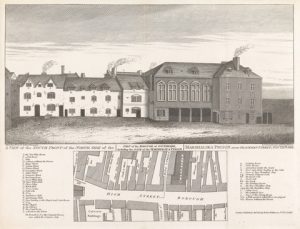
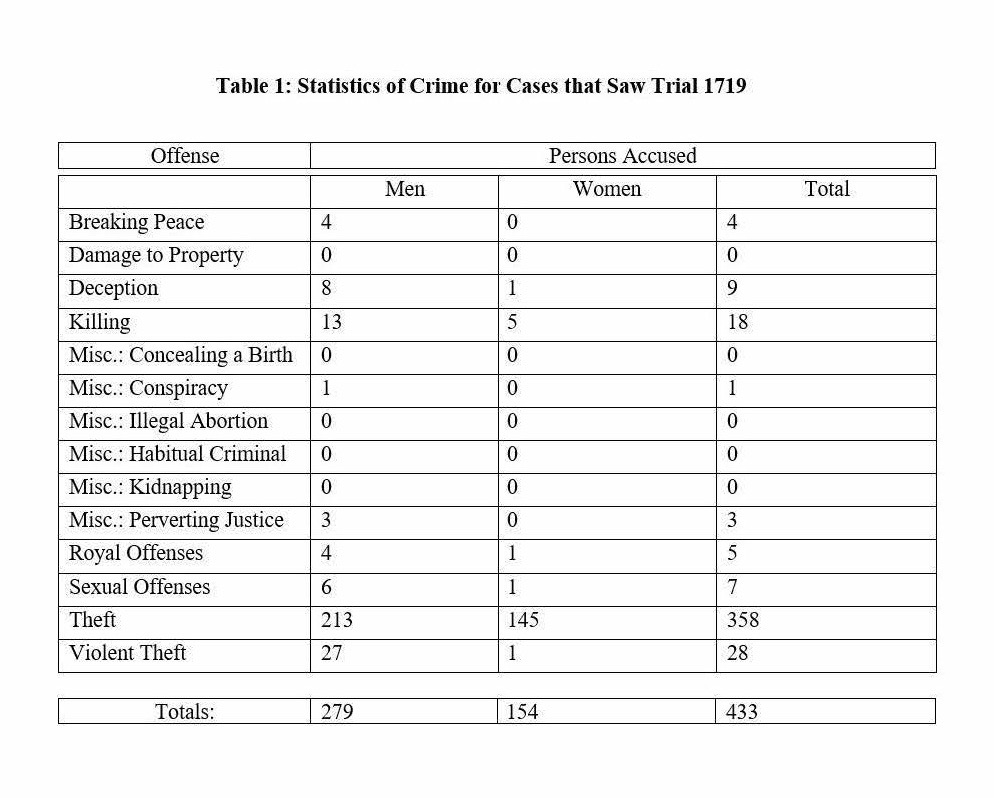 The statistics of crimes committed in the eighteenth century show that women stood trial far less than men. The Old Bailey Online reveals that from the 1690s to the 1740s, women accounted for 40% of defendants. This number significantly declined over the course of the eighteenth century, until reaching as low as 22% at the start of the nineteenth century (“Gender in the Proceedings”). In accordance, in examining the archives, I found that of the estimated 48,000 cases that saw trial from 1701 to 1800, about 69% consisted of male defendants, while 31% were female. Since 2019 marks the 300th anniversary of the publication of Love in Excess, I examined the 433 cases that went to trial in 1719: 154 involved female defendants, whereas 279 involved male defendants (Table 1). Although the majority of female defendants faced trials centered on killing and theft, their crimes were likely to be focused on their failure to adhere to expectations ascribed to their gender. These gendered crimes included infanticide, concealing a birth, unlawful abortion, theft, and coining (including keeping a brothel) (“Gender in the Proceedings”). Additionally, of the 154 females that stood trial in the year 1719, only 86 were found guilty, 10 of whom successfully received a respite for pregnancy (Table 2).
The statistics of crimes committed in the eighteenth century show that women stood trial far less than men. The Old Bailey Online reveals that from the 1690s to the 1740s, women accounted for 40% of defendants. This number significantly declined over the course of the eighteenth century, until reaching as low as 22% at the start of the nineteenth century (“Gender in the Proceedings”). In accordance, in examining the archives, I found that of the estimated 48,000 cases that saw trial from 1701 to 1800, about 69% consisted of male defendants, while 31% were female. Since 2019 marks the 300th anniversary of the publication of Love in Excess, I examined the 433 cases that went to trial in 1719: 154 involved female defendants, whereas 279 involved male defendants (Table 1). Although the majority of female defendants faced trials centered on killing and theft, their crimes were likely to be focused on their failure to adhere to expectations ascribed to their gender. These gendered crimes included infanticide, concealing a birth, unlawful abortion, theft, and coining (including keeping a brothel) (“Gender in the Proceedings”). Additionally, of the 154 females that stood trial in the year 1719, only 86 were found guilty, 10 of whom successfully received a respite for pregnancy (Table 2).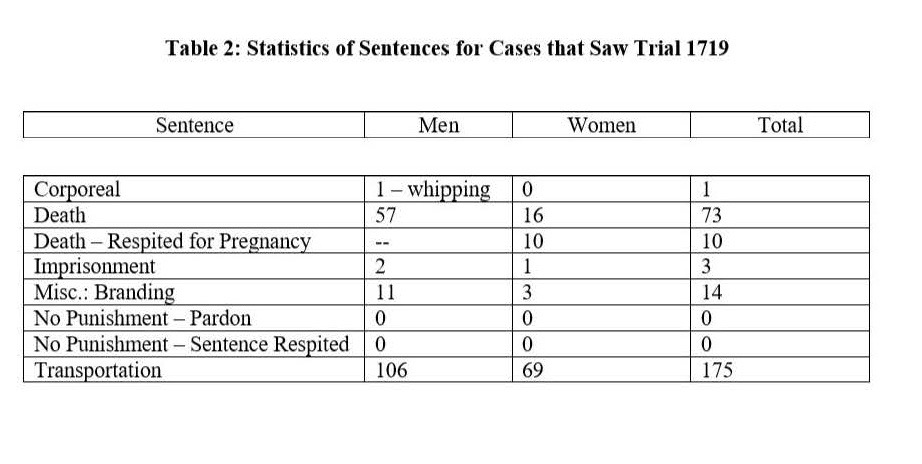 One reason behind female theft could be the economic hardships that women encountered in London. Specifically, women’s wages were significantly lower than men’s and rarely guaranteed. Knowing this, it should be no surprise to suggest that women perhaps participated in various acts of theft to make ends meet. Of the 145 female theft cases in 1719, 15 involved shoplifting. Chloe Wigston-Smith discusses her examination of the Old Bailey Online proceedings in her book Women, Work and Clothes in the Eighteenth-Century Novel (2013) and notes that many stolen items involved textiles, garments, or accessories. She further explains how some women used their own clothes to assist in shoplifting (Wigston-Smith 95). Similarly, I found a case in 1719 of Mary Wilson, who was taken to trial for stealing four pairs of Worsted stockings. When she was apprehended, authorities found the stockings hidden “up her Coats” (“Mary Wilson”). Wilson was found guilty and sentenced to transportation. In addition to clothing, women would use accessories to assist in shoplifting. Urphane Mackhoule, for example, was found guilty in 1719 for stealing a pair of silver buckles. She did this by entering a shop and requesting some aniseed to distract the merchant. When the merchant turned his back, Mackhoule placed the buckles in her basket. She later confessed and was also sentenced to transportation (“Urphane Mackhoule”). Although the proceedings do not address specifically why Wilson and Mackhoule were stealing stockings and buckles, it is reasonable to infer that female acts of shoplifting could be rooted in an inability to afford the items they needed or desired due to economic hardships brought on by the gendered wage gap.
One reason behind female theft could be the economic hardships that women encountered in London. Specifically, women’s wages were significantly lower than men’s and rarely guaranteed. Knowing this, it should be no surprise to suggest that women perhaps participated in various acts of theft to make ends meet. Of the 145 female theft cases in 1719, 15 involved shoplifting. Chloe Wigston-Smith discusses her examination of the Old Bailey Online proceedings in her book Women, Work and Clothes in the Eighteenth-Century Novel (2013) and notes that many stolen items involved textiles, garments, or accessories. She further explains how some women used their own clothes to assist in shoplifting (Wigston-Smith 95). Similarly, I found a case in 1719 of Mary Wilson, who was taken to trial for stealing four pairs of Worsted stockings. When she was apprehended, authorities found the stockings hidden “up her Coats” (“Mary Wilson”). Wilson was found guilty and sentenced to transportation. In addition to clothing, women would use accessories to assist in shoplifting. Urphane Mackhoule, for example, was found guilty in 1719 for stealing a pair of silver buckles. She did this by entering a shop and requesting some aniseed to distract the merchant. When the merchant turned his back, Mackhoule placed the buckles in her basket. She later confessed and was also sentenced to transportation (“Urphane Mackhoule”). Although the proceedings do not address specifically why Wilson and Mackhoule were stealing stockings and buckles, it is reasonable to infer that female acts of shoplifting could be rooted in an inability to afford the items they needed or desired due to economic hardships brought on by the gendered wage gap.